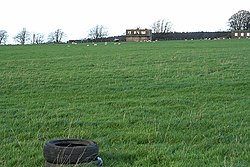
Royal Air Force Tangmere or more simply RAF Tangmere is a former Royal Air Force station located in Tangmere, England, famous for its role in the Battle of Britain.

Royal Air Force Abingdon, or more simply RAF Abingdon, is a former Royal Air Force station near Abingdon, Oxfordshire. It is now known as Dalton Barracks and is used by the Royal Logistic Corps.
Royal Air Force Long Kesh, or more simply RAF Long Kesh, is a former Royal Air Force station at Maze, Lisburn, Northern Ireland.
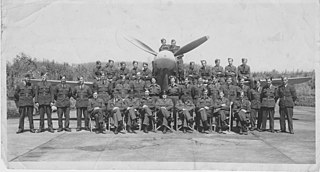
Royal Air Force Ballyhalbert or more simply RAF Ballyhalbert is a former Royal Air Force station at Ballyhalbert on the Ards Peninsula, County Down, Northern Ireland
Royal Air Force Blackbushe or more simply RAF Blackbushe is a former Royal Air Force station in Hampshire, England, during the Second World War. It is now Blackbushe Airport.

Tain Air Weapons Range is a Ministry of Defence air weapons range on the Dornoch Firth near Tain in Scotland. Royal Air Force aircrews from RAF Lossiemouth are trained in air weaponry on the range, along with NATO aircrew.
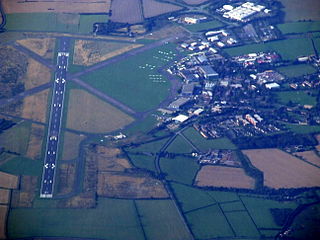
Cranfield Airport is an airfield just outside the village of Cranfield, in Bedfordshire, England. It is 7 NM south-west of Bedford and 5.5 NM east of Milton Keynes. It was originally a Second World War aerodrome, RAF Cranfield. It is now used for business aviation, private flights, and for research and development activities.
Royal Air Force Bircham Newton or more simply RAF Bircham Newton is a former Royal Air Force station located 2.1 miles (3.4 km) south east of Docking, Norfolk and 13.4 miles (21.6 km) north east of King's Lynn, Norfolk, England.
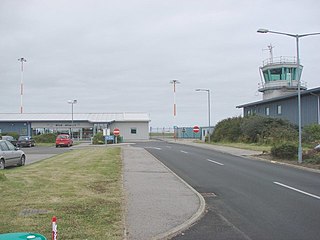
Wick John O' Groats Airport is located one nautical mile north of the town of Wick, at the north-eastern extremity of the mainland of Scotland. It is owned and maintained by Highlands and Islands Airports Limited. The airport provides commercial air travel connections for Caithness, with scheduled services to Aberdeen Airport and, until early 2020, Edinburgh. It remains regularly used by helicopters servicing local offshore oil operations and the Beatrice Offshore Windfarm. It also serves as a stop-over for light aircraft ferry flights between Europe and North America via Iceland. The airport also operates an out of hours call-out service for air ambulances, coastguard and police flights.

Royal Air Force Colerne or more simply RAF Colerne is a former Royal Air Force station which was on the outskirts of the village of Colerne in Wiltshire, England, and was in use from 1939 to 1976.
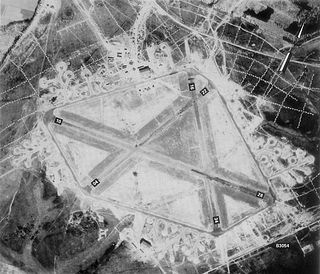
Royal Air Force Beaulieu or more simply RAF Beaulieu is a former Royal Air Force station in the New Forest, Hampshire, England. It was also known as Beaulieu airfield, Beaulieu aerodrome and USAAF Station AAF 408. It is located on Hatchet Moor 1 mile (2 km) west of the village of East Boldre, about 2 miles (3 km) west-southwest of the village of Beaulieu and 4 miles (6 km) north-east of Lymington.

Royal Air Force Westhampnett or more simply RAF Westhampnett is a former Royal Air Force satellite station, located in the village of Westhampnett near Chichester, in the English County of West Sussex.

Royal Air Force Detling, or more simply RAF Detling, is a former Royal Air Force station situated 600 feet (180 m) above sea level, located near Detling, a village about 4 miles (6.4 km) miles north-east of Maidstone, Kent.

Royal Air Force Acklington, simply known as RAF Acklington, is a former Royal Flying Corps and Royal Air Force station located 3.2 miles (5.1 km) south west of Amble, Northumberland and 8.8 miles (14.2 km) north east of Morpeth, Northumberland.
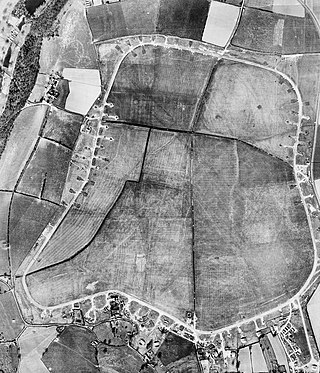
Royal Air Force Zeals, or more simply RAF Zeals, is a former Royal Air Force station in Wiltshire, sited to the north of the village of Zeals, next to the village of Stourton and the Stourhead estate.
Royal Air Force Bramcote, or more simply RAF Bramcote, is a former Royal Air Force station located 3.5 miles (5.6 km) south-east of Nuneaton, Warwickshire, England used during the Second World War. It was later transferred to the Admiralty and was known as Royal Naval Air Station Bramcote,, and when commissioned became HMS Gamecock. When it subsequently transferred to the British Army from the Admiralty, it was called Gamecock Barracks.

Royal Air Force Bradwell Bay or more simply RAF Bradwell Bay is a former Royal Air Force station located 9.5 miles (15.3 km) east of Maldon, Essex, England and 3.1 miles (5 km) south west of West Mersea, Essex.
RAF Appledram is a former Royal Air Force Advanced Landing Ground 2.3 miles (3.7 km) southwest of Chichester, West Sussex and 12.2 miles (19.6 km) east of Portsmouth, Hampshire.

Royal Air Force Church Fenton or RAF Church Fenton is a former Royal Air Force (RAF) station located 4.3 miles (6.9 km) south-east of Tadcaster, North Yorkshire, England and 6.3 miles (10.1 km) north-west of Selby, North Yorkshire, near the village of Church Fenton.

Royal Air Force Charmy Down or more simply RAF Charmy Down is a former Royal Air Force station in Somerset, England, approximately 3 miles (4.8 km) north-northeast of Bath and 96 miles (154 km) west of London.
